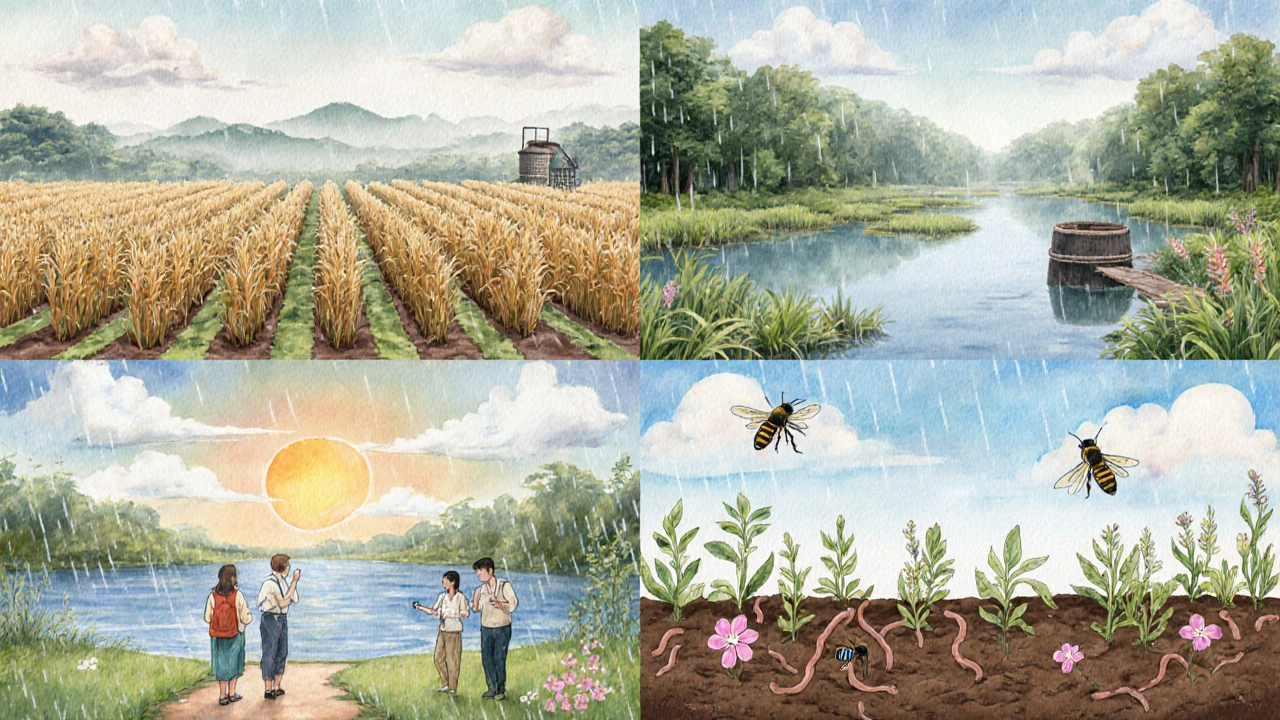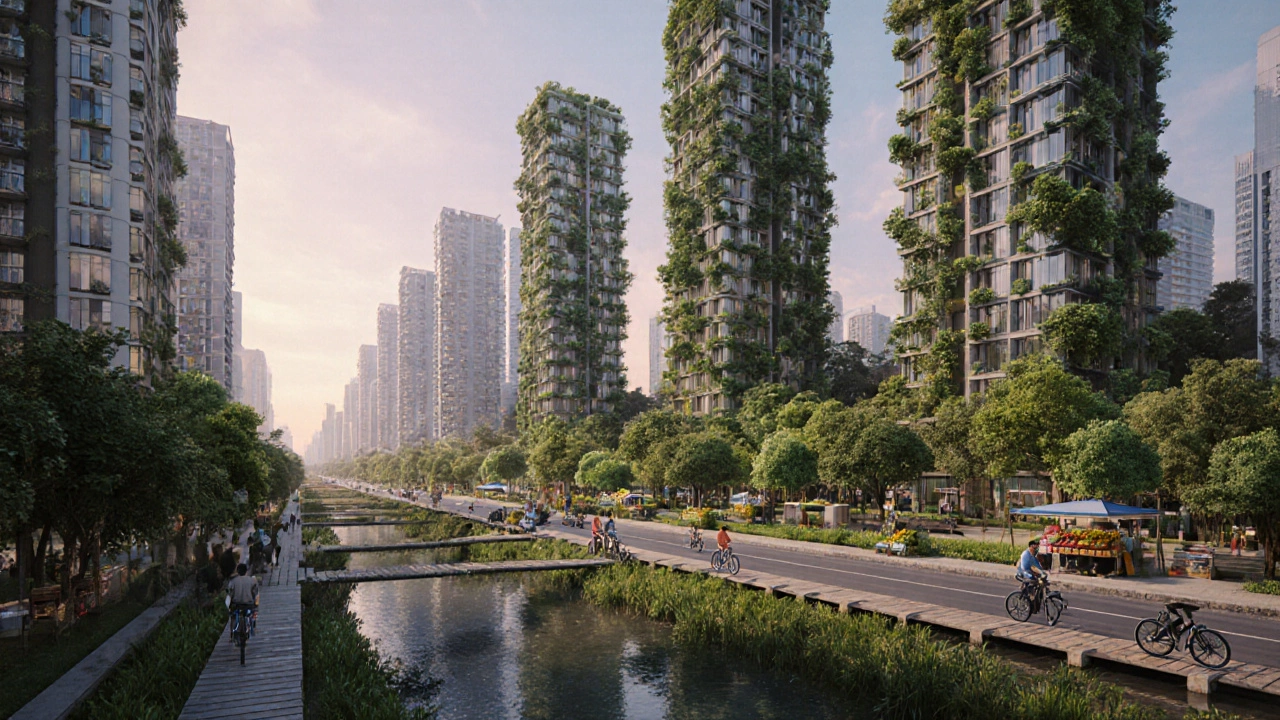Environmental Services Categorization Quiz
Identify the Environmental Service Category
Which category does this example belong to?
How to Play
Test your knowledge of the four core categories of environmental services:
- Provisioning Direct resources for human use
- Regulating Stabilizes climate, water, and health
- Cultural Recreational, aesthetic, spiritual value
- Supporting Foundational processes for all other services
Your Score:
0/0
When we talk about the natural world supporting human life, environmental services are the invisible hands that keep our food on the table, clean water flowing, and the air we breathe safe. In simple terms, they are the benefits people obtain from healthy ecosystems. Understanding the four main categories helps anyone-from a city planner to a school‑age kid-see why protecting nature isn’t a luxury, it’s a necessity.
What Exactly Are Environmental Services?
Environmental services (often called ecosystem services) cover a wide range of functions that natural systems perform for humans. They include everything from the pollination of crops by bees to the calming effect of a forest walk. The United Nations’ Millennium Ecosystem Assessment first grouped these benefits into four clear categories, and that framework still guides policy, research, and community projects worldwide.
1. Provisioning Services
Provisioning services are the tangible products we harvest directly from nature. Think of them as the “what we get” part of the equation. They include:
- Food crops like wheat, rice, and corn.
- Freshwater drawn from rivers, lakes, and aquifers.
- Timber for construction and furniture.
- Medicinal plants that form the basis of many drugs.
- Raw materials such as minerals and fibers.
These resources feed millions, fuel economies, and provide the raw inputs for countless industries. Without reliable provisioning services, food prices would sky‑rocket, and many communities would face severe shortages.
2. Regulating Services
Regulating services are the natural processes that keep environmental conditions stable. They act like the planet’s built‑in thermostat and filter. Key examples include:
- Carbon sequestration by forests and soils, which helps curb climate change.
- Air purification through the absorption of pollutants by trees and moss.
- Water purification and flood regulation performed by wetlands and riparian zones.
- Pest control by natural predators such as ladybugs and birds.
- Regulation of disease vectors-wetlands can reduce mosquito breeding sites.
When these services falter, we see more extreme weather, poorer air quality, and higher rates of disease. That’s why cities invest in green infrastructure like rain gardens and urban forests.
3. Cultural Services
Cultural services capture the non‑material benefits we enjoy from nature. They’re harder to measure but equally vital for well‑being. They include:
- Recreational opportunities-hiking, fishing, birdwatching.
- Aesthetic values-landscape beauty that inspires art and tourism.
- Spiritual and religious significance-sacred groves, rivers, and mountains.
- Educational resources-field trips that teach ecology and biology.
- Sense of place and cultural identity tied to local ecosystems.
Studies show that access to green spaces lowers stress, improves mental health, and even boosts city property values. In short, cultural services turn nature into a source of joy, identity, and inspiration.
4. Supporting Services
Supporting services are the underlying processes that make the other three categories possible. They’re like the soil that holds a seed before it sprouts. Core supporting services are:
- Soil formation and nutrient cycling that sustain plant growth.
- Primary production-photosynthesis that creates the organic matter all other life depends on.
- Habitat provision for biodiversity, which in turn fuels provisioning and regulating services.
- Pollination and seed dispersal mechanisms essential for food crops.
Without these foundational services, even the most spectacular forests or pristine rivers would eventually lose their ability to provide food, clean water, or recreation.

Why the Four‑Category Model Matters
Policymakers, NGOs, and businesses use the four‑category framework to assess natural capital. It helps answer questions like:
- Which ecosystem functions are most valuable to a coastal town dependent on fisheries?
- How can a city justify the cost of a new wetlands park?
- What trade‑offs emerge when a forest is cleared for agriculture?
By assigning economic and social value to each category, decision‑makers can weigh short‑term gains against long‑term sustainability.
Measuring Environmental Services
Quantifying these services isn’t straightforward, but several tools have emerged:
- The InVEST (Integrated Valuation of Ecosystem Services and Tradeoffs) software models how changes in land use affect provisioning, regulating, and cultural services.
- Life Cycle Assessment (LCA) tracks the environmental impact of products from raw material extraction through disposal.
- Natural Capital Accounting (NCA) integrates ecosystem values into national accounts, as seen in the United Kingdom’s “Green GDP” pilot.
These methods help translate the “intangible” into numbers that can sit alongside dollars and euros in a budget spreadsheet.
Real‑World Examples
Seeing the categories in action makes them less abstract. Here are three brief case studies:
- New Zealand’s Rutland Water Wetlands: Restoration projects boosted water purification (regulating), created bird‑watching sites (cultural), and increased fish stocks (provisioning).
- Kenya’s Maasai Mara Conservancy: Protected grazing lands sustain wildlife tourism (cultural), preserve predator‑prey dynamics that control herbivore overgrazing (regulating), and support pastoralist livestock (provisioning).
- Germany’s Forest Carbon Credit Scheme: Mature forests lock away carbon (regulating), provide timber (provisioning), and serve as recreation spots (cultural). The scheme also maintains soil health (supporting).
Each example shows how the four categories overlap, reinforcing why holistic management is essential.
Challenges and Threats
Human activities continue to erode these services at an alarming rate:
- Deforestation reduces carbon sequestration, disrupts water cycles, and harms cultural values tied to forests.
- Urban sprawl replaces wetlands, diminishing flood regulation and water purification.
- Overfishing depletes provisioning services while also harming supporting services like marine biodiversity.
Climate change amplifies all of these risks, making it crucial to embed environmental services into climate adaptation strategies.

How Individuals Can Support Environmental Services
You don’t need a Ph.D. to protect these services. Simple actions add up:
- Plant native trees or shrubs to boost carbon capture and habitat.
- Support local farms that practice regenerative agriculture, protecting soil health.
- Reduce water waste at home; every liter saved eases pressure on natural purification systems.
- Visit and volunteer at nearby parks, wetlands, or community gardens.
- Advocate for policies that fund green infrastructure and protect critical habitats.
Collective effort keeps the flow of environmental services strong for future generations.
Quick Reference Table
| Category | Main Benefits | Typical Examples |
|---|---|---|
| Provisioning | Direct resources for human use | Food crops, fresh water, timber, medicinal plants |
| Regulating | Stabilizes climate, water, and health | Carbon sequestration, flood control, air purification |
| Cultural | Recreational, aesthetic, spiritual value | Hiking trails, scenic vistas, sacred sites |
| Supporting | Foundational processes for all other services | Soil formation, pollination, nutrient cycling |
Looking Ahead
As the planetary budget tightens, integrating the four categories into every level of decision‑making becomes non‑negotiable. From city planners allocating land for green corridors to multinational corporations accounting for ecosystem impacts, the language of environmental services is moving from academic journals into boardrooms and community meetings.
Frequently Asked Questions
What is the difference between environmental services and ecosystem services?
Both terms describe the benefits people get from nature, but "environmental services" is often used in policy contexts, while "ecosystem services" appears more in scientific literature. The underlying concepts are the same.
Can cultural services be quantified?
Quantifying cultural services is challenging, but methods like contingent valuation surveys and visitor‑count statistics give monetary estimates for recreation and tourism benefits.
Why are supporting services considered “foundation” services?
Supporting services like soil formation and pollination underpin provisioning, regulating, and cultural services. If the foundation erodes, the entire ecosystem benefits collapse.
How does climate change affect regulating services?
Warmer temperatures can reduce the capacity of forests to sequester carbon and alter precipitation patterns, weakening flood regulation and water purification functions.
What are practical ways for a city to protect environmental services?
Cities can adopt green roofs, preserve riparian buffers, create urban wetlands, and enforce zoning that protects natural habitats. Each action supports multiple service categories.





